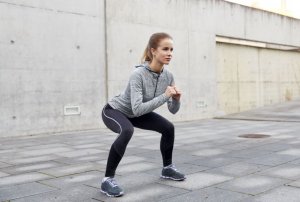Glute Exercises: Five Keys to Getting Excellent Results

One of the most common problems at the gym is that our glute exercises do not give us the results we want. Sometimes it is due to focusing too much on them. Sometimes we are not using the right weights. In this article, we will take a look at the keys to ensuring your glute exercises pay off.
Tips for effective glute exercises
Generally more of a workout focus for women, the glutes are something of a dicey area, as they seem to have a mind of their own. It can take a lot of effort to get them the way we want. Do not get discouraged and abandon your routine. The following tips will help you get results:
1. Don’t just work out your glutes
Not only is this the biggest muscle in the body, it is also the area where the most fat accumulates in women. Often, the glutes can seem just plain uncooperative. One of the most common errors people make at the gym is to focus solely on this area at the expense of everything else.

Do not neglect your legs, your abdomen, and your back when planning your routine. Keep in mind that the exercises to strengthen the glutes the most are squats and lunges. These also work out your quads, your calves, and your knees. Also, to get firm thighs, you need to work out the other muscles as well.
Another thing to remember: do not work your glutes every session. The muscles need time to rest and recover from the effort. Wait at least 48 hours before returning to the muscle group. If you go to the gym every day, alternate with exercises for your upper body or cardio.
2. Be consistent
Once you start working out, it is very important that you stick to your schedule. Working out as hard as you can at the gym for one day is useless if you spend the rest of the week sitting around at work or on the couch.
No matter what your goal is, consistency produces results. And when dealing with such a mercurial area, even more attention and commitment is required.
3. Use less weight
Using lots of weight is not always synonymous with good results. When it comes to glute exercises, you may observe effects that are the opposite of what you want. We would even recommend not adding any weight to the routine when you are getting started.
You can begin with free squats in order to strengthen the knees and prevent injury to the lumbar area. Ideally, you will add weight with practice. A bit of advice: use the amount of weight that allows you to do 15 repetitions without overexerting yourself.

4. Set an attainable goal
Obviously, we would all love to get amazing glutes that are the source of envy during summer vacation. But you cannot hope to achieve this goal if you start two weeks before heading to the beach!
Visualize your goal and do everything you can to make it a reality. This way, you will not be disappointed or depressed. It is also recommended that you set intermediate goals to give you the encouragement you need to keep going.
Glute exercises are not magic. You will need to put in at least one month of consistent work in order to see progress. Do not become obsessed with this particular area. Work on your whole body in order to get a more harmonious result.
5. Control the number of repetitions
This is not about doing hundreds of repetitions every time you go to the gym. Not only could you hurt yourself and suffer from cramps and spasms, but after a certain point your muscles will cease to cooperate, regardless of how many times you exert them.
Ideally, your glute routine should consist of between eight and twelve repetitions per set (and no more than three sets). If you do fewer repetitions, you will gain strength, but will not see any muscle growth. And if you exceed the recommended amount, you will tire out the muscle, resulting in slower growth.
One of the most common problems at the gym is that our glute exercises do not give us the results we want. Sometimes it is due to focusing too much on them. Sometimes we are not using the right weights. In this article, we will take a look at the keys to ensuring your glute exercises pay off.
Tips for effective glute exercises
Generally more of a workout focus for women, the glutes are something of a dicey area, as they seem to have a mind of their own. It can take a lot of effort to get them the way we want. Do not get discouraged and abandon your routine. The following tips will help you get results:
1. Don’t just work out your glutes
Not only is this the biggest muscle in the body, it is also the area where the most fat accumulates in women. Often, the glutes can seem just plain uncooperative. One of the most common errors people make at the gym is to focus solely on this area at the expense of everything else.

Do not neglect your legs, your abdomen, and your back when planning your routine. Keep in mind that the exercises to strengthen the glutes the most are squats and lunges. These also work out your quads, your calves, and your knees. Also, to get firm thighs, you need to work out the other muscles as well.
Another thing to remember: do not work your glutes every session. The muscles need time to rest and recover from the effort. Wait at least 48 hours before returning to the muscle group. If you go to the gym every day, alternate with exercises for your upper body or cardio.
2. Be consistent
Once you start working out, it is very important that you stick to your schedule. Working out as hard as you can at the gym for one day is useless if you spend the rest of the week sitting around at work or on the couch.
No matter what your goal is, consistency produces results. And when dealing with such a mercurial area, even more attention and commitment is required.
3. Use less weight
Using lots of weight is not always synonymous with good results. When it comes to glute exercises, you may observe effects that are the opposite of what you want. We would even recommend not adding any weight to the routine when you are getting started.
You can begin with free squats in order to strengthen the knees and prevent injury to the lumbar area. Ideally, you will add weight with practice. A bit of advice: use the amount of weight that allows you to do 15 repetitions without overexerting yourself.

4. Set an attainable goal
Obviously, we would all love to get amazing glutes that are the source of envy during summer vacation. But you cannot hope to achieve this goal if you start two weeks before heading to the beach!
Visualize your goal and do everything you can to make it a reality. This way, you will not be disappointed or depressed. It is also recommended that you set intermediate goals to give you the encouragement you need to keep going.
Glute exercises are not magic. You will need to put in at least one month of consistent work in order to see progress. Do not become obsessed with this particular area. Work on your whole body in order to get a more harmonious result.
5. Control the number of repetitions
This is not about doing hundreds of repetitions every time you go to the gym. Not only could you hurt yourself and suffer from cramps and spasms, but after a certain point your muscles will cease to cooperate, regardless of how many times you exert them.
Ideally, your glute routine should consist of between eight and twelve repetitions per set (and no more than three sets). If you do fewer repetitions, you will gain strength, but will not see any muscle growth. And if you exceed the recommended amount, you will tire out the muscle, resulting in slower growth.
This text is provided for informational purposes only and does not replace consultation with a professional. If in doubt, consult your specialist.








